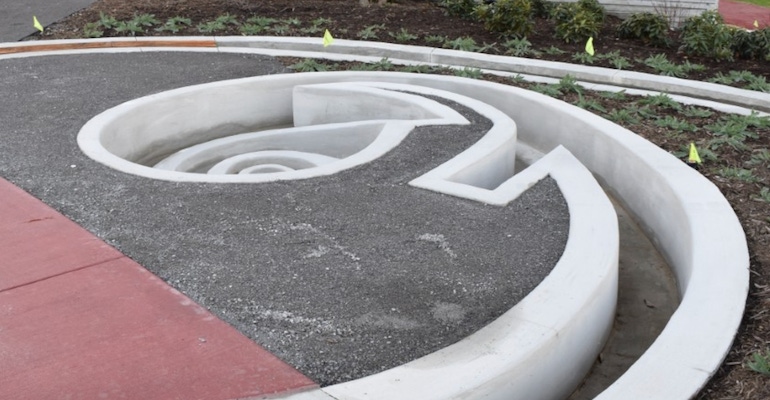The project consists of a new “cap” structure that spans a portion of I-579 in Pittsburgh, a large-scale urban development project that aims to create additional urban living space.
August 9, 2022

A large-scale urban development project along I-579 that aims to create urban living space has been collecting awards for the unique concrete features that it showcases.
The project created a "cap" structure over the highway in Pittsburgh.
The surface area created a new three-acre public open space with accessible pedestrian pathways and bicycle routes. The work also brought in improvements to adjoining intersections; provided recreation, educational, and performance areas; rain gardens for stormwater management, and included design elements developed by artists from the neighborhood and other public amenities.
Crews installed 1,700 linear feet of individually formed architectural walls and sidewalk with color and exposed aggregate surface features, 126 concrete adjacent box beams at 140,000 pounds each, 500,000 pounds of rebar, 2,500 cubic yards of concrete 1,300 linear feet of drilled caissons and 14,400 linear feet of micropiles.
The City of Pittsburgh’s $32 million I-579 Urban Open Space Cap Project was selected for an award from the Northeast Association of State Transportation Officials (NASTO) for quality of live improvements and community development. The project, awarded to Fay, S&B USA Construction, is predominantly based on concrete, with features like a rain garden that have been included in the design.
"One of the most unique concrete features is a colored paving pattern depicting the sankofa bird," said Katie Spear, Shikun & Binui USA's Vice President of Marketing.
Construction began in 2019 and was completed in late 2021.
"The biggest challenge with the cast-in-place work on the large structures was the accessibility," said Chuck Grabner, Fay, S&B USA Construction's Sr. Project Manager. "All 42 caissons, 42 columns and four pier caps had to be poured with a concrete pump on an on/off ramp adjacent to traffic on I-579."
Crews were able to pour concrete in the winter months over two construction seasons.
"During the first winter in 2019-2020, we focused on the large structure pours for the bridge substructure work," said Chuck Grabner. "During the second winter in 2020-2021, we focused on all of the architectural wall concrete work. At times, the work progressed around the clock. For the most part, the project team worked day shifts. During large deck pours we had to push all 9 pours to the night shift due to hot temperature concerns during daylight hours. The schedule was very aggressive at all times and extremely tight."
The plan of attack included installing 42 caissons for the columns, followed by 232 micropiles for the project's abutments. The next steps were the installation of the precast concrete box beams, large deck pours, sidewalk work, and 60 cast-in-place walls. Flatwork was completed at the end of the project.
A Manitowoc MLC 300 crane lifted the 126 concrete beams.
"The crane was set on an engineered crane pad, as the crane and beam weight combination was almost 1,000,000 lbs. at full capacity," said Chuck Grabner, "The beams were staged during the daylight hours since DOT permits only allow Supermax loads to be mobilized during the day. Once off-loaded, the night shift crew would erect the beams under I-579 temporary closures. Each beam took about 1 hour to install. Only 6 beams could be delivered each day due to the Supermax load DOT permits."
Careful planning went into the installation of the individually formed architectural walls and exposed aggregate-concrete sidewalks.
"Peri Rund-Flex forms allowed us to pour over 60 cast-in-place walls that all had different depths and radii," said Chuck Grabner. "Each panel was adjusted to a custom fit for each curve of the wall. Once poured, the panels were stripped and adjusted for the next wall. The walls were poured utilizing a Kobelco 140 excavator with a concrete bucket. The sidewalks were installed with similar equipment."
CBS Concrete supplied the concrete, Titusville Fabricators the rebar, and Northeast Prestressed Products (NPP) the beams. CH&D Enterprises poured the sidewalks.
The project won several additional awards for engineering, construction and sustainability.
Read more about:
sustainabilityAbout the Author(s)
You May Also Like


